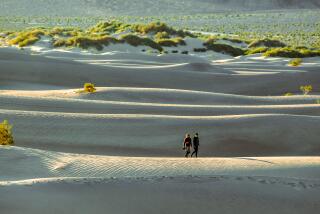Scientists Baffled by Boiling Lake That Isn’t
- Share via
LAUDAT, Dominica — Boiling Lake, this Caribbean island’s most exotic tourist lure, has ceased to simmer.
For nearly four months, the volcanic crater’s usually bubbling brew has been calm, except for brief surges when water inexplicably drains away, then rises again. The temperature rises and falls, sometimes hot enough to send up steam clouds, other times so tepid that adventurous visitors have dared to swim in it. The color has varied from gray-green to alabaster, and, most recently, black as coal.
The mysterious changes have scientists scratching their heads and hikers skipping the seven-hour round-trip trek that many found adventurous enough without added risks.
“The lake has stopped boiling at times in the past, but what worries us about this case is that the changes are drastic and really, really fast,” said Nicolas Fournier, a volcanologist with the Seismic Research Unit of the University of the West Indies in Trinidad and Tobago.
The 200-foot-wide lake is a crater filled by underground rivulets and rainwater and heated by volcanic gases.
Since the boiling stopped in late December, the water level has fluctuated, dropping as much as 40 feet, leaving a sludgy pool of gray sediment on the bottom and a ring of mineral residue. Water normally so hot that it can cook an egg in five minutes cooled to a tepid 68 degrees in January, when a party of Austrian hikers ventured in.
Boiling Lake has baffled Dominicans before. In 1887, 1900, 1971 and 1988, the lake water calmed and drained away through the fumaroles that funnel heat from beneath the crusted lava lake bed. But each time, the water level and temperature returned to normal within a few weeks.
Fournier speculates that a magnitude 6.3 earthquake north of Dominica on Nov. 21 caused the thick mineral sediment on the lake floor to shift and clog the fissures from which volcanic heat had been reaching the water.
But he is at a loss to explain why the water level has been fluctuating so dramatically.
Arlington James, Dominica’s chief forestry officer, has made 10 treks to the lake since Dec. 24, when a tour group reported that the water had stopped boiling and the crater was no longer covered by a steam cloud.
“People are really baffled by what the lake is doing now. It seems able to empty and refill itself very quickly,” James said. During an April 13 visit, the lake was nearly full and its water black from what he suspects was iron sulfide. The water temperature was up to 138 degrees, twice as warm as it had been a month earlier yet far below its usual 197 degrees.
James said he has noticed a drop in the hiking traffic since the boiling ceased. On one recent weekday, the trail was empty.
“People are tentative about going down there now,” he said of the rugged route from Laudat that takes hikers through rain forest, along narrow ridges, up steep rocky inclines and through the aptly named Valley of Desolation.
The volcano sits in Morne Trois Pitons National Park, which has been marked as a World Heritage site by the United Nations.
In 1900, when the lake stopped boiling for a month, a Dominican guide and two tourists were peering into the nearly drained crater when a sudden belch of sulfurous gas issued from beneath the water. The guide and one of his charges were knocked unconscious by the fumes and fell to their deaths, Fournier said.
Although scientists aren’t sure what is causing the lake’s water to ebb and flow, they say they doubt that it presages a volcanic eruption.
“I’m sure if anything was going to happen, there would be precursory events like earthquakes or other seismic activity,” said Cecil Shillingford, head of the island’s Disaster Preparedness Office.
Seismic meters at nine stations across the island’s 290 square miles have not registered unusual activity, Shillingford said.
Fournier said there was a risk of “phreatic eruption,” or blasts of steam and gas, but noted that if molten lava was trying to force itself to the surface, the water temperature would be rising faster.
Tourism officials have kept the trail open despite the uncertainty, and Fournier is confident that the lake’s volatility poses little hazard to Dominica’s 70,000 residents or its 300,000 annual tourists. But, he said, he advised Dominican tourism officials to discourage hikers from getting too close to the crater, especially on calm days when there is no wind to disperse gases.
Last year, more than 10,000 visitors trekked to Boiling Lake, the world’s second-largest such crater. The biggest of these phenomena is a simmering lake in Rotorua, New Zealand.
Parks official Dave Williams said there had been a surge in day hikes to Morne Trois Pitons’ lakes and waterfalls over the last few years after cruise ship companies discovered the natural wonders of Dominica.
At the National Development Corp., which arranges access to Dominica’s rugged interior, spokeswoman Samantha Smith said interest in the lake had been holding steady despite its unpredictable behavior.
Visitors are always advised to hire guides for the treacherous trail, on which many turn back and dozens each year are injured.
“The recommendation is for people not to get too close and not to linger,” said Fournier, who will be leading a seismologists’ trek to the lake in May.
“They should get in, get their look, then get out of there. And obviously they should not go swimming!”
More to Read
Sign up for Essential California
The most important California stories and recommendations in your inbox every morning.
You may occasionally receive promotional content from the Los Angeles Times.












